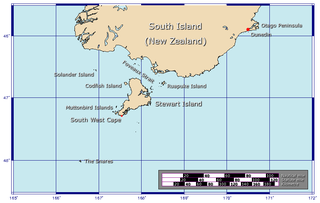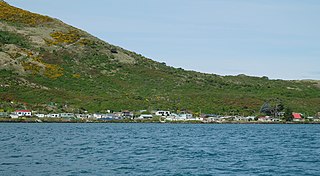Related Research Articles

Waikouaiti is a small town in East Otago, New Zealand, within the city limits of Dunedin. The town is close to the coast and the mouth of the Waikouaiti River.

The Otago Peninsula is a long, hilly indented finger of land that forms the easternmost part of Dunedin, New Zealand. Volcanic in origin, it forms one wall of the eroded valley that now forms Otago Harbour. The peninsula lies south-east of Otago Harbour and runs parallel to the mainland for 20 km, with a maximum width of 9 km. It is joined to the mainland at the south-west end by a narrow isthmus about 1.5 km wide.

Otago Harbour is the natural harbour of Dunedin, New Zealand, consisting of a long, much-indented stretch of generally navigable water separating the Otago Peninsula from the mainland. They join at its southwest end, 21 km (13 mi) from the harbour mouth. It is home to Dunedin's two port facilities, Port Chalmers and at Dunedin's wharf. The harbour has been of significant economic importance for approximately 700 years, as a sheltered harbour and fishery, then deep water port.

Dunedin is the second-largest city in the South Island of New Zealand, and the principal city of the Otago region. Its name comes from Dùn Èideann, the Scottish Gaelic name for Edinburgh, the capital of Scotland. The city has a rich Scottish, Chinese and Māori heritage.

The Foveaux Strait, separates Stewart Island, New Zealand's third largest island, from the South Island. The strait is about 130 km long, and it widens and deepens from east to west. The strait lies within the continental shelf area of New Zealand, and was probably dry land during the Pleistocene epoch.

Otakou is a settlement within the boundaries of the city of Dunedin, New Zealand. It is located 25 kilometres from the city centre at the eastern end of Otago Peninsula, close to the entrance of Otago Harbour. Though a small fishing village, Otakou is important in the history of Otago for several reasons. The settlement is the modern centre and traditional home of the Ōtākou rūnanga (assembly) of Ngāi Tahu. In 1946 Otakou Fisheries was founded in the township; this was later to become a major part of the Otago fishing industry.

Moturata, also called Taieri Island, is an island in the mouth of the Taieri River in southern New Zealand. It is connected to the mainland by a sandy causeway at low tide.

Taiaroa Head is a headland at the end of the Otago Peninsula in New Zealand, overlooking the mouth of the Otago Harbour. It lies within the city limits of Dunedin. The nearest settlement, Otakou, lies three kilometres to the south.
William Tucker was a British convict, a sealer, a trader in human heads, an Otago settler, and New Zealand’s first art dealer.

The settlement of Harington Point lies within the boundaries of the city of Dunedin, New Zealand. It is located at the Otago Heads, at the northeastern end of Otago Peninsula, close to the entrance of Otago Harbour. The mouth of the harbour is at its narrowest at Harington Point, only some 400 metres separating the point from the mudflats at Aramoana on the opposing coast.
New Zealand's Otago region is one of the more isolated outliers of the inhabited earth. Its high latitude, elevation and distance from larger foreign and domestic population centers has defined Otago at each stage of its history.
The following lists events that happened during 1839 in New Zealand.
The following lists events that happened during 1835 in New Zealand.
The following lists events that happened during 1831 in New Zealand.
The following lists events that happened during 1827 in New Zealand.
There is a drastic decline in the number of ships visiting New Zealand from the previous year. An economic depression starts in New South Wales as a result of the escalation of war in Europe and the consequent reduction in the number of convicts being transported. In March news of the Boyd massacre reaches Port Jackson and a punitive expedition is sent to New Zealand and bombards the village of the incorrectly blamed chief, Te Pahi. After this the few whaling ships that later head for New Zealand usually prefer to avoid landing, especially in the Bay of Islands.
Foveaux Strait is the centre of attention for sealing ships. Sealing gangs are dropped along the coast from southern Fiordland to Otago Harbour and on Stewart Island/Rakiura. The Bay of Islands is sometimes on the journey to or from Port Jackson. The Chatham Islands are also visited. A few whalers also operate around New Zealand; some also collect timber from Bay of Islands.
The Sealers' War (1810–1821) in southern New Zealand, also known as the "War of the Shirt", was a series of often indiscriminate attacks and reprisals between Māori and European sealers. Initially minor misunderstandings between the two peoples quickly led to armed conflict. This resulted in a period of mistrust and animosity between Māori and sealers fueling several conflicts, leading to the deaths of about 74 people and the burning of the village of Otakou on the Otago Peninsula. Records exist from both sides of the conflict but not from any impartial observers.

Commercial whaling in New Zealand waters began late in the 18th century and continued until 1965. It was a major economic activity for Europeans in New Zealand in the first four decades of the 19th century. Nineteenth-century whaling was based on hunting the southern right whale and the sperm whale and 20th-century whaling concentrated on the humpback whale.
"Soon May the Wellerman Come", also known as "Wellerman" or "The Wellerman", is a sea ballad from New Zealand first documented in the 1960s. The song refers to the "wellermen", pointing to supply ships owned by the Weller brothers, who were amongst the earliest European settlers of Otago.
References
- Entwisle, Peter. "Weller, Edward 1814?–1893". Dictionary of New Zealand Biography . Ministry for Culture and Heritage . Retrieved 9 April 2011.
- The Weller Brothers in the 1966 Encyclopaedia of New Zealand
- Entwisle, P. in Griffiths G. (ed) (1974) The Advance Guard Series 3 Edward Weller Dunedin, NZ: Otago Daily Times.
- Entwisle, P. (1998) Behold the Moon the European Occupation of the Dunedin District 1770–1848 Dunedin, NZ: Port Daniel Press. ISBN 0-473-05591-0.
- King, Alexandra (2010). The Weller's whaling station : the social and economic formation of an Otakou community, 1817-1850 (BA(Hons)). Dunedin: University of Otago.